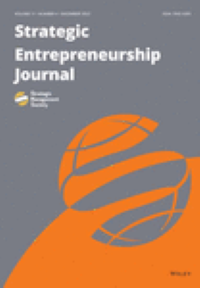Integrating multimodal data and machine learning for entrepreneurship research
IF 5.4
2区 管理学
Q1 BUSINESS
引用次数: 0
Abstract
Research SummaryExtant research in neuroscience suggests that human perception is multimodal in nature—we model the world integrating diverse data sources such as sound, images, taste, and smell. Working in a dynamic environment, entrepreneurs are expected to draw on multimodal inputs in their decision making. However, extant research in entrepreneurship has largely focused on how entrepreneurs or investors develop insights from data in a single mode. A few studies that have used a multimodal approach either simplify the multimodal data (MMD) into a few constructs or manually analyze the data without fully utilizing their potential. Such oversimplification limits the insights that can be gained from MMD. In this paper, we offer a framework to guide researchers to analyze and integrate MMD, capturing various cues embedded in the entrepreneurial process. We illustrate how applying machine learning algorithms to MMD can engender a robust, reliable, and scalable approach for researchers to effectively capture the elusive yet critical aspects of entrepreneurial phenomena. We also curate a set of data and algorithm resources for researchers interested in leveraging MMD in their studies.Managerial SummaryEntrepreneurs operate in fast‐paced and complex environments where success often relies on the ability to make sense of diverse and rich information, which ranges from explicit observations (e.g., what they see and hear) to more subtle contextual cues. Yet, most entrepreneurship research focuses on analyzing data in a single mode, such as only texts or numbers. Our research highlights the importance of embracing multimodal data (整合多模态数据和机器学习用于创业研究
现有的神经科学研究表明,人类的感知本质上是多模态的——我们将声音、图像、味道和气味等不同的数据源整合在一起,为世界建模。在一个充满活力的环境中工作,企业家期望在他们的决策中利用多种模式的投入。然而,现有的创业研究主要集中在企业家或投资者如何在单一模式下从数据中获得见解。一些使用多模态方法的研究要么将多模态数据(MMD)简化为几个结构,要么在没有充分利用其潜力的情况下手动分析数据。这种过度简化限制了从MMD中获得的洞察力。在本文中,我们提供了一个框架来指导研究人员分析和整合MMD,捕捉嵌入在创业过程中的各种线索。我们说明了如何将机器学习算法应用于MMD可以为研究人员提供一个强大、可靠和可扩展的方法,以有效地捕捉创业现象中难以捉摸但关键的方面。我们还为有兴趣在他们的研究中利用MMD的研究人员策划了一组数据和算法资源。企业家在快节奏和复杂的环境中运作,成功往往依赖于理解多样化和丰富信息的能力,这些信息从明确的观察(例如,他们看到和听到的)到更微妙的上下文线索。然而,大多数创业研究侧重于以单一模式分析数据,例如仅使用文本或数字。我们的研究强调了采用多模态数据(MMD)的重要性,它结合了各种格式,如音频、图像、视频和文本,以更好地理解和解释企业决策。我们介绍了一个实用的框架和一套机器学习技术,帮助管理人员和研究人员利用丰富的多模态数据。我们的方法不是简化或手动分析多模式数据,而是允许对创业过程进行可扩展、系统和可靠的洞察。对于从业者来说,这意味着更好的工具来评估项目,跟踪团队动态,或者实时感知市场趋势。为了支持采用,我们还提供了一组精心策划的MMD资源和算法,组织可以利用这些资源和算法来做出更明智的战略决策。
本文章由计算机程序翻译,如有差异,请以英文原文为准。
求助全文
约1分钟内获得全文
求助全文
来源期刊

Strategic Entrepreneurship Journal
Multiple-
CiteScore
11.10
自引率
1.60%
发文量
31
期刊介绍:
The Strategic Entrepreneurship Journal is a research journal that publishes original work recommended by a developmental, double-blind review process conducted by peer scholars. Strategic entrepreneurship involves innovation and subsequent changes which add value to society and which change societal life in ways which have significant, sustainable, and durable consequences. The SEJ is international in scope and acknowledges theory- and evidence-based research conducted and/or applied in all regions of the world. It is devoted to content and quality standards based on scientific method, relevant theory, tested or testable propositions, and appropriate data and evidence, all replicable by others, and all representing original contributions. The SEJ values contributions which lead to improved practice of managing organizations as they deal with the entrepreneurial process involving imagination, insight, invention, and innovation and the inevitable changes and transformations that result and benefit society.
 求助内容:
求助内容: 应助结果提醒方式:
应助结果提醒方式:


